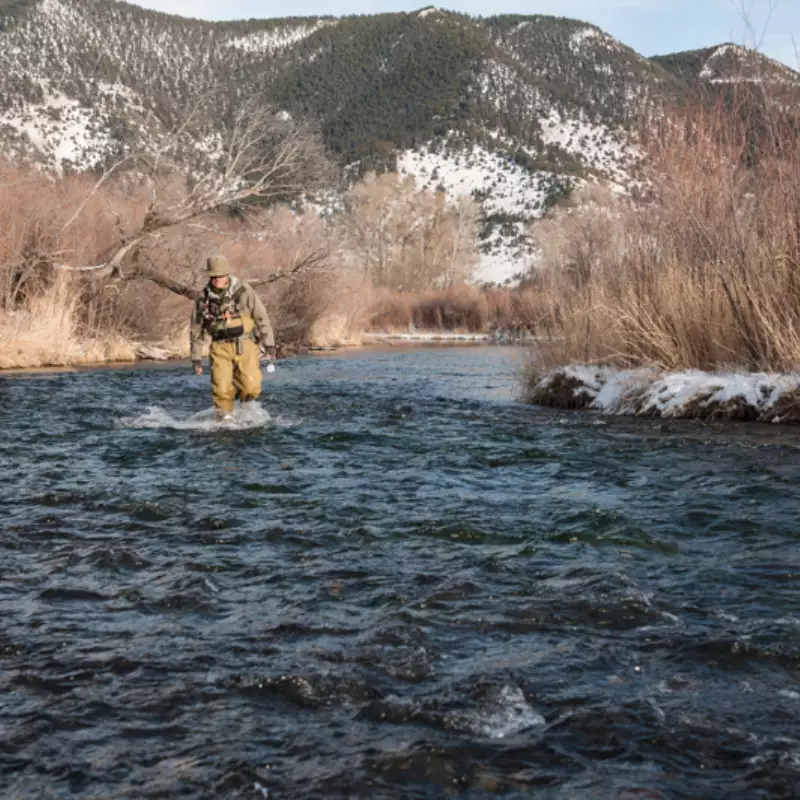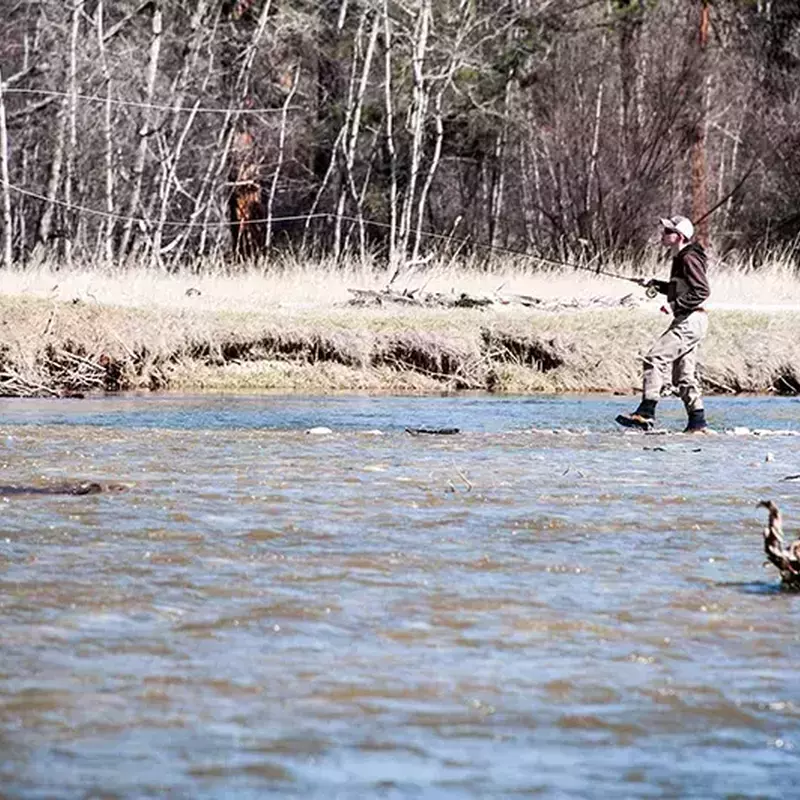9 Hatch Matching Dry Flies For Fall Fly Fishing in Montana
Posted by: Alex
Date: 10/15/2025
As the water cools and clouds roll in as summer fades away, mayfly hatches reappear and become the experienced angler’s focus while fly fishing in Montana during the fall. These guide tested top 9 hatch matching dry flies are proven winners when rising trout reappear.
Fall is one of the best times of year for dry fly fishing in Montana. The crowds thin out, the weather cools down, and trout feed steadily through the changing conditions. While many anglers switch to nymphs or streamers this time of year, fall mayfly hatches can bring some terrific "match the hatch" dry fly fishing during prolific mayfly emergences.
After a summer of fly fishing attractors and terrestrials, fall is a nice reminder for both our guests and guides that trout can be highly selective when food sources are more abundant and active. By the time Labor Day rolls around, we find ourselves digging deep into the fly boxes for hatch matching flies once again. These top 9 hatch matching dry flies are proven winners when the fall hatches renew on rivers and streams across the Treasure State

1) Parachute Adams
If there’s one dry fly that belongs in every box, it’s the Parachute Adams. This classic and versatile dry fly imitates just about any mayfly that hatches here in Montana during the fall. Its low-riding profile and neutral color make it perfect for matching everything from Hecuba to blue-winged olive mayflies that emerge throughout the fall on the fly fishing waters near Bozeman.
In sizes 16 to 20, it’s effective on every piece of water around Bozeman. Our guides fish it solo on calm days or use it as the lead fly in a dry-dropper setup when trout are feeding just below the surface.

2) Purple Haze
The Purple Haze has become one of Montana’s most popular modern dry flies. Its purple body gives off a subtle hue that catches light and stands out in overcast conditions. It fishes much like a Parachute Adams but adds that little something extra that makes it work great whether prospecting over likely holding water or working risers.
In the fall, trout key in on smaller mayflies and midges, and the Purple Haze in sizes 16 to 20 works well as an attractor pattern during low water and calm conditions.

3) CDC Comparadun
The CDC Comparadun is an essential small, dry fly pattern for fall fly fishing in Montana near Bozeman. It imitates adult mayflies perfectly, sitting flush in the film with natural movement from the CDC fibers. The bwo version is a constant companion for anglers fishing the Paradise Valley spring creeks through the fall and spring.
Our guides stock up on these - primarily in sizes 16-18 - to cover situations where presentation matters most during the best mayfly hatches of the fall.

4) Griffith's Gnat
When the weather turns cold and hatches get sparse, midges become the only hatching insects of note. The Griffith’s Gnat is highly visible, enabling it to be fished in calm or riffled water. It’s one of the simplest dry flies ever tied, but it continues to outfish more complicated patterns in the right conditions and produces on picky trout throughout the year.
On the lower Madison and East Gallatin, fish it in sizes 18 through 22. Look for slower water, soft seams, and foam lines where trout rise steadily.

5) Olive Missing Link
This Mike Mercer original is an all-around essential for dry fly fishing in Montana throughout the fall. From western green drake to blue-winged olive, this innovative pattern is one of the more effective and versatile dries in our fly box today. Whether fish are feeding steadily to emerging duns or are favoring cripples, the missing link is a must for serious anglers.
The deer hair wings stand out for angler visibility while the hook shank sits low in the water, in the typical feeding zone of rising trout during a heavy hatch.

6) Parachute Hare's Ear
Similar in design and profile to the Parachute Adams and Purple Haze, this is our "go-to" dry fly when working rising fish in September. The color is just right for the Hecuba mayflies that are prolific on the Yellowstone River near Bozeman and the western rivers around Missoula. The classic calf-tail wing is easy to see and stands out nicely when naturals are in abundance.
Sizes 12-14 are fall essentials for dry fly fishing in Montana and the northeast corner of Yellowstone National Park on the Lamar and Soda Butte Creek.

7) Goddard Caddis
Although October Caddis hatches are hardly "prolific" on treble-ribbon rivers and streams near Bozeman, there always seems to be a few days a year when the trout are really looking for them on the lower Madison River in late September and early October.
Most true October Caddis patterns have an orangish hue to them but we have found that the standard Goddard does the trick just fine in a size 10 or 12.

8) Hairwing Green Drake
Western Red Quills and Hecuba (sometimes referred to as one and the same)mayfly are around in good numbers on cloudy days throughout the early fall. Fish are typically eager to take a well-presented dry fly when the hatches are most prolific.
The Hairwing Drake pattern floats high in riffles and fast runs when conditions can make for tough visibility. This is a good one to have in sizes 12-14 when working fish in fast water.

9) Cosmic Crane
If the Beaverhead River is one of your fall haunts, you know that big fish eat craneflies when hatches are sparse. These large bugs flutter and skitter over the water's surface with erratic movements that sometimes attract the most wary of trout when few other flies will do the trick.
The Cosmic Crane sits hook up on the water and can be fished dead-drifted or twitched. Try dapping it above the surface with a large soft hackle dropper about 2' below it off a blood-knot tagend.
Tips for Fall Dry Fly Fishing in Montana
- Fall dry fly fishing around Bozeman and throughout Montana is about timing more than anything else. Trout feed most actively when water temperatures rise just enough to get insects moving—usually from late morning through early afternoon. Cloudy days are best for blue-winged olive hatches, but even calm, sunny afternoons can bring pods of fish to the surface if you look in the right places.
- Success in the fall often comes down to presentation. Trout have seen a summer’s worth of flies and pressure, so drag-free drifts matter more now than ever. Lighter tippets—5X or 6X—help your fly land softly, and longer leaders keep line away from the fish. If you find trout refusing your pattern, ensure that you are getting drag-free drifts first before changing flies.
- Another key to consistent success is observation. Spend time watching before casting. Look for subtle dimples, soft rises, or the flash of a feeding trout under the surface. In the fall, trout won’t always show themselves aggressively, but when they do, they’re usually holding in the same rhythm. Match your timing and drift to that rhythm, and you’ll hook more fish.
- Lastly, always keep an eye on weather and water clarity. Cold fronts can shift conditions fast, especially in southwest Montana. Overcast skies and light rain equate to better hatches, while windy, bright days push trout down. Fall fly fishing in Montana rewards anglers who are prepared and flexible.
Fish and Learn With A Pro
Join Fins and Feathers Guide Service on a guided fly fishing trip to learn more about dry fly fishing opportunities around Bozeman during the fall months. We have been outfitting Bozeman MT. fly fishing trips for over two decades and enjoy showcasing the legendary dry fly fishing on our local rivers as much as anything else we do throughout the year. Reservations can be placed online, through e-mail, or by calling us at 1-406-468-5019.
Related Articles From the Montana Fly Fishing Blog

Category: Bozeman Fly Fishing Trip Planning
Planning a Guided Trip to Fly Fish Montana in the Fall
Post Date: 10/20/2025
Fall in Montana offers a completely different kind of fly fishing trip than during the busy summer months. Our Bozeman area rivers all fish great, and there are fewer drift...
Read Article

